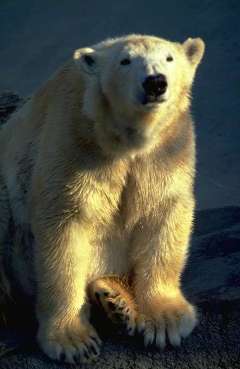Overview
Order: Carnivora
Family: Ursidae
Species: Ursus maritimus
IUCN Status: vulnerable species
Distribution: northern polar regions occurring in 5 nations - Greenland, Norway, Canada, United States and Russia and also on Arctic sea pack ice usually within 300km of land. Some individuals wander up to 200km inland.
Population: 22,000 to 31,000 with 60% living in Canada.
Habitat: favourite habitat is a combination of pack ice, open water and coastal land.
 Description: coat colour varies from pure white to shades of yellow. Small ears; black eyes and nose.
Description: coat colour varies from pure white to shades of yellow. Small ears; black eyes and nose.
Height: 1.6m to shoulder
Length: 2.2 - 2.5m.
Size of feet: 30cm long, 25cm wide.
Weight: male 400 - 650 kg, female 300 - 350kg. Polar bears have actually shrunk in size compared to their predecessors in the early 20th century. This could be because of pollution and shrinking sea ice making it harder for them to find food and therefore grow.
Life span: about 30 years.
The polar bear is the world's largest land carnivore and one of the largest of the bear family, alongside with the omnivorous Kodiak bear which can sometimes weigh over 900 kg.
Read More: Polar Bear Habits